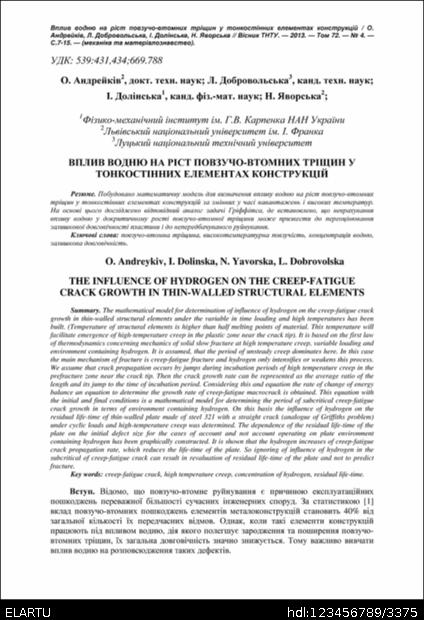Mesedez, erabili identifikatzaile hau item hau aipatzeko edo estekatzeko:
http://elartu.tntu.edu.ua/handle/123456789/3375

| Titulua: | Вплив водню на ріст повзучо-втомних тріщин у тонкостінних елементах конструкцій |
| Beste titulu batzuk: | The influence of hydrogen on the creep-fatigue crack growth in thin-walled structural elements |
| Egilea: | Добровольська, Л. Долінська, Ірина Ярославівна Яворська, Н. Andreykiv, O. Dolinska, I. Yavorska, N. Dobrovolska, L. |
| Bibliographic description (Ukraine): | Вплив водню на ріст повзучо-втомних тріщин у тонкостінних елементах конструкцій / О. Андрейків, Л. Добровольська, І. Долінська, Н. Яворська // Вісник ТНТУ — Тернопіль : ТНТУ, 2013. — Том 72. — № 4. — С 7-15. — (механіка та матеріалознавство). The influence of hydrogen on the creep-fatigue crack growth in thin-walled structural elements / O. Andreykiv, I. Dolinska, N. Yavorska, L. Dobrovolska // Bulletin of TNTU — Ternopil : TNTU, 2013. — Volume 72. — No 4. — P 7-15. — (mechanics and materials science). |
| Gordailuaren-data: | 19-Nov-2013 |
| Date of entry: | 3-Sep-2014 |
| Argitalpen: | Тернопiльський національний технiчний унiверситет iменi Iвана Пулюя |
| Place of the edition/event: | Тернопіль |
| UDC: | 539 431 434 669.788 |
| Gako-hitzak: | повзучо-втомна тріщина високотемпературна повзучість концентрація водню залишкова довговічність creep-fatigue crack high temperature creep concentration of hydrogen residual life-time |
| Laburpena: | Побудовано математичну модель для визначення впливу водню на ріст повзучо-втомних
тріщин у тонкостінних елементах конструкцій за змінних у часі навантажень і високих температур.
На основі цього досліджено відповідний аналог задачі Гріффітса, де встановлено, що неврахування
впливу водню у докритичному рості повзучо-втомної тріщини може призвести до переоцінювання
залишкової довговічності пластини і до непередбачуваного руйнування. The mathematical model for determination of influence of hydrogen on the creep-fatigue crack growth in thin-walled structural elements under the variable in time loading and high temperatures has been built. (Temperature of structural elements is higher than half melting points of material. This temperature will facilitate emergence of high-temperature creep in the plastic zone near the crack tip). It is based on the first law of thermodynamics concerning mechanics of solid slow fracture at high temperature creep, variable loading and environment containing hydrogen. It is assumed, that the period of unsteady creep dominates here. In this case the main mechanism of fracture is creep-fatigue fracture and hydrogen only intensifies or weakens this process. We assume that crack propagation occurs by jumps during incubation periods of high temperature creep in the prefracture zone near the crack tip. Then the crack growth rate can be represented as the average ratio of the length and its jump to the time of incubation period. Considering this and equation the rate of change of energy balance an equation to determine the growth rate of creep-fatigue macrocrack is obtained. This equation with the initial and final conditions is a mathematical model for determining the period of subcritical creep-fatigue crack growth in terms of environment containing hydrogen. On this basis the influence of hydrogen on the residual life-time of thin-walled plate made of steel 321 with a straight crack (analogue of Griffiths problem) under cyclic loads and high-temperature creep was determined. The dependence of the residual life-time of the plate on the initial defect size for the cases of account and not account operating on plate environment containing hydrogen has been graphically constructed. It is shown that the hydrogen increases of creep-fatigue crack propagation rate, which reduces the life-time of the plate. So ignoring of influence of hydrogen in the subcritical of creep-fatigue crack can result in revaluation of residual life-time of the plate and not to predict fracture. |
| URI: | http://elartu.tntu.edu.ua/handle/123456789/3375 |
| ISSN: | 1727-7108 |
| Copyright owner: | © „Вісник Тернопільського національного технічного університету“ |
| Content type: | Article |
| Bildumetan azaltzen da: | Вісник ТНТУ, 2013, № 4 (72) |
Item honetako fitxategiak:
| Fitxategia | Deskribapena | Tamaina | Formatua | |
|---|---|---|---|---|
| TNTUB_2013v72n4_O_Andreykiv-The_influence_of_hydrogen_7-15.pdf | 376,01 kB | Adobe PDF | Bistaratu/Ireki | |
| TNTUB_2013v72n4_O_Andreykiv-The_influence_of_hydrogen_7-15.djvu | 204,25 kB | DjVu | Bistaratu/Ireki | |
| TNTUB_2013v72n4_O_Andreykiv-The_influence_of_hydrogen_7-15__COVER.png | 194,71 kB | image/png | Bistaratu/Ireki |
DSpaceko itemak copyright bidez babestuta daude, eskubide guztiak gordeta, baldin eta kontrakoa adierazten ez bada.